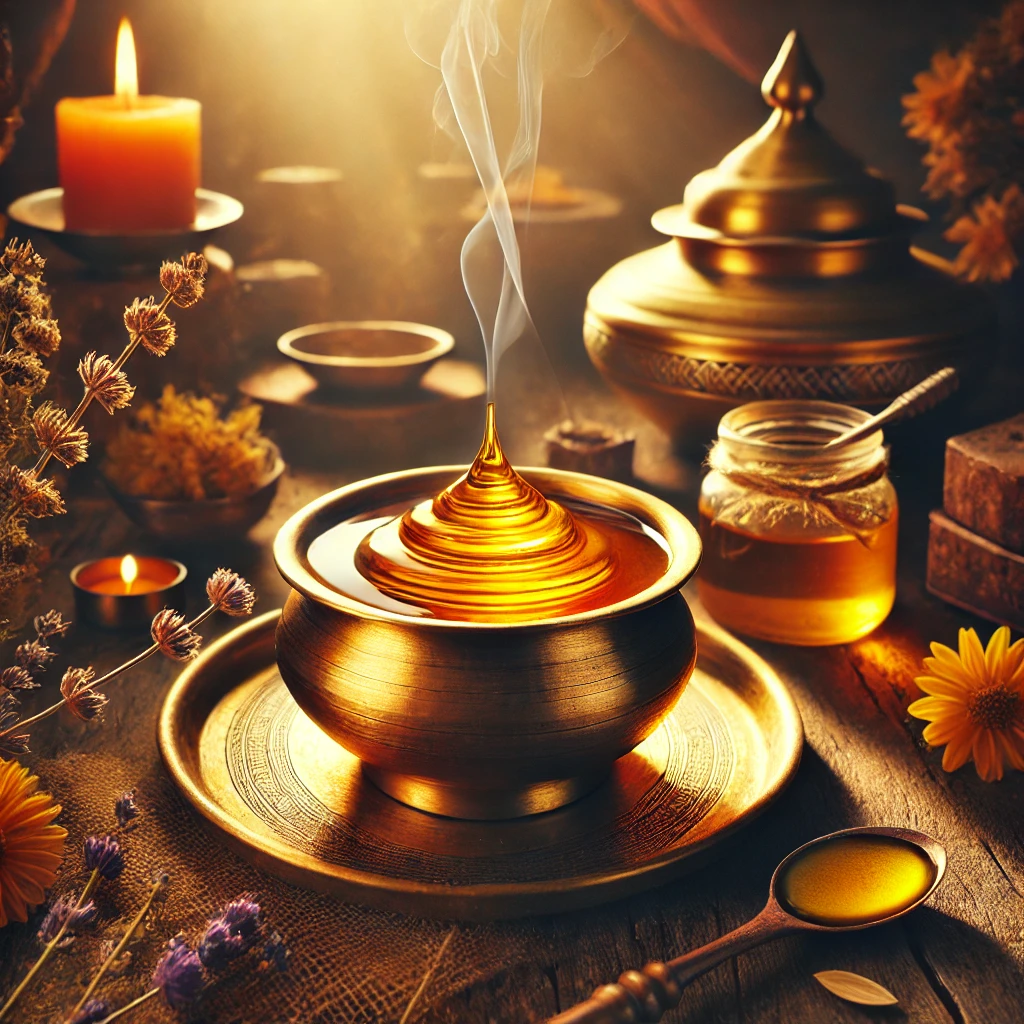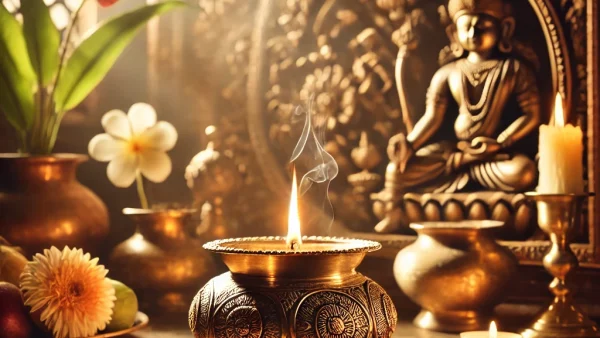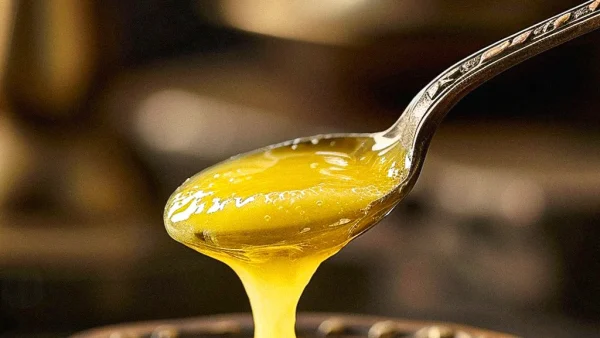Golden Essence of Hindu Tradition
Ghee, known in Tamil as “நெய்” (nei), has held a sacred place in Hinduism and Ayurvedic practices, symbolizing purity, nourishment, and spiritual transformation. More than just a culinary ingredient, ghee embodies the essence of traditional rituals, meditation, and health. From the ancient Vedic scriptures to modern-day kitchens, ghee has retained its status as both a food and a spiritual offering. But did you know there are several types of ghee, each with its unique qualities, benefits, and uses?
In this in-depth guide, we’ll explore the various types of ghee, their significance in Hindu culture, and how each type offers unique benefits. Whether you’re exploring Hindu traditions or simply curious about the health benefits of ghee, this article will guide you through the different varieties of this “liquid gold.”
What is Ghee?
Ghee is a clarified form of butter, made by simmering butter until the water evaporates and the milk solids separate, leaving behind a golden liquid. Rich in healthy fats, ghee is renowned for its high smoke point, making it ideal for cooking, and it has a long shelf life due to its low moisture content. But beyond its practical applications, ghee is cherished in Hinduism as a symbol of sustenance, used in rituals like fire sacrifices (yajna) and as an offering to deities.
Today, the versatility of ghee extends beyond its role in religious ceremonies, providing numerous health benefits. It is rich in omega-3 fatty acids, vitamins A, D, E, and K, and butyrate—a short-chain fatty acid linked to digestive health. Its richness in flavor and aroma makes it ideal for both culinary and therapeutic uses.
Types of Ghee
While all ghee may seem similar on the surface, each type has specific qualities that make it distinct. From cow to buffalo ghee, to plant-based and infused varieties, let’s dive into the diverse types of ghee.
1. Cow Ghee: The Traditional Favorite
Cow ghee is perhaps the most widely recognized form of ghee, made from the milk of Indian or grass-fed cows. In Hindu culture, cow ghee is regarded as “sattvic,” or pure, and is believed to promote mental clarity and tranquility. It’s also considered one of the most potent “ojas”-enhancing foods in Ayurveda, enhancing vitality and energy.
- Health Benefits: Cow ghee is known for aiding digestion, improving immunity, and supporting heart health due to its high levels of conjugated linoleic acid (CLA) and butyric acid. According to Ayurveda, cow ghee is also excellent for balancing Vata and Pitta doshas.
- Religious Significance: Cow ghee is a staple in Hindu rituals, used in temple lamps, yajnas (sacrificial fires), and for anointing statues of deities. The offering of cow ghee to Agni, the fire god, is said to be a way of honoring divine energy.
2. Buffalo Ghee: Rich and Robust
Buffalo ghee, made from buffalo milk, is popular in many parts of South India and is known for its rich, creamy texture and higher fat content. It has a slightly stronger taste and a darker color than cow ghee.
- Health Benefits: Due to its high-fat content, buffalo ghee is ideal for those needing extra energy, particularly during heavy physical work or cold weather. It’s also richer in minerals like calcium and magnesium.
- Religious and Cultural Use: Buffalo ghee is less commonly used in religious rituals, as cow ghee is considered more auspicious in Hinduism. However, it’s often used in traditional Indian sweets and for culinary purposes.
3. A2 Ghee: The Purest Form of Cow Ghee
A2 ghee comes from A2 cows, which are a specific breed like Gir or Sahiwal cows, producing only A2 beta-casein protein in their milk. A2 ghee is believed to be easier to digest than other types of ghee.
- Health Benefits: A2 ghee is valued for its easy digestibility and high content of omega-3 fatty acids. It is often recommended for people with dairy sensitivities, as it lacks A1 protein, which some find difficult to digest.
- Spiritual Perspective: Some believe that A2 ghee from indigenous Indian cows is more potent spiritually, carrying a more profound vibrational quality suited for meditation and deepening one’s spiritual practice.
4. Herbal or Medicated Ghee: Infused for Healing
Herbal or medicated ghee, known as “ghrita” in Ayurveda, is infused with medicinal herbs. This type of ghee is specifically used in Ayurvedic treatments and is designed to carry the healing properties of the herbs into the body effectively.
- Common Types of Herbal Ghee:
- Brahmi Ghee: Used for mental clarity and memory.
- Ashwagandha Ghee: Known to boost stamina and relieve stress.
- Triphala Ghee: Aids digestion and detoxification.
- Health Benefits: Depending on the herbs used, medicated ghee offers a range of benefits, from enhanced cognitive function to improved immune response.
- Spiritual Application: Medicated ghee is used in Ayurveda for spiritual cleansing and grounding, offering a unique blend of nutrition and medicinal benefits.
5. Desi Ghee: Authentic and Indigenous
Desi ghee is made from the traditional churning method of curd. Unlike modern production methods, desi ghee is typically crafted in small batches, allowing for a purer taste and texture.
- Health Benefits: Known for its digestive and anti-inflammatory properties, desi ghee is especially helpful for those with weak digestive systems.
- Cultural Relevance: In India, desi ghee is revered in rural households, and it’s believed that the slow-churning process adds to the purity and energy of the final product.
Ghee in Hinduism: Symbolism and Spirituality
In Hinduism, ghee is far more than an ingredient—it’s a sacred substance that symbolizes purity, prosperity, and nourishment. Its use in religious ceremonies, particularly yajnas (fire offerings), is deeply symbolic. The act of pouring ghee into the fire is considered a form of spiritual sacrifice, where one offers their desires, ego, and impurities to be purified.
In the Bhagavad Gita, ghee is seen as a symbol of spiritual fuel that sustains the soul. This ritualistic use of ghee represents an offering to the divine, fostering a sense of connection and devotion to higher consciousness.
Real-Life Application: Using Ghee in Personal Rituals
For those interested in incorporating Hindu practices into their daily lives, lighting a lamp with ghee can be a simple yet powerful way to bring blessings into the home. It is said that the aroma of burning ghee purifies the atmosphere and invokes divine presence. Additionally, consuming a small amount of ghee each morning is believed to enhance mental clarity and support a meditative practice.
Buying Pure Ghee for Rituals and Cooking
Selecting the right ghee for your needs is essential, especially when considering its sacred and health-promoting qualities. If you’re looking for pure, high-quality ghee that meets both culinary and ritual needs, visit spiritualguru.lk, where you can find authentic ghee sourced with care and reverence for its traditional value.
Embracing the Diversity of Ghee
In Hindu culture, ghee is a timeless substance that connects us to our roots, to our health, and to the divine. Whether used for cooking, Ayurvedic healing, or spiritual practices, the various types of ghee provide something for everyone. Each type, from cow ghee to herbal ghee, carries unique benefits that reflect the wisdom of ancient traditions.
By choosing the right type of ghee, you can connect with both the spiritual and practical dimensions of this golden essence. So why not start incorporating this versatile, sacred substance into your life and experience the richness it brings to both body and soul?




Leave a comment